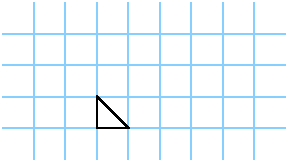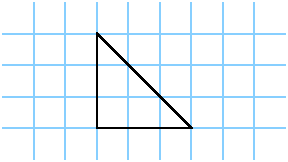


|

|
|
| kein Kreuzungspunkt | nicht konvex |
Spielen Sie mit diesen Figuren und finden Sie heraus, welche Tripel (b,i,a) Sie konstruieren können. Wenn ich also sage (3,0,1/2), zeichnen Sie das linke Bild,


| Datum | Titel, Stichworte | SE/proSE | Referenz(en) | Vortragende(r) |
| 14.10. | Hallo erstmal | |||
| 21.10. | Polarität von Polygonen konvexe Hülle endlich vieler Punkte = beschränkte Lösungsmenge endlich vieler linearer Ungleichungen; Polarität "vertauscht" Ecken und Kanten. |
SE | [JT, §§3.1-3.3, §5.3] |
Felix Lorenz |
| 28.10. | unimodulare Äquivalenz, HNF proSE unimodulare Matrizen, flächenerhaltend, viele Beispiele, Klassifikation von Kegeln mittels Hermite-Normalform | proSE | [HNP, §2.1] [HS, §0.3] |
Jannes Siems |
| 04.11. | Pick, Ehrhart Picks Formel für Dreiecke, für Polygone; Korollar: Ehrhart-Polynom, Reziprozität (brauchen Euler-Formel für 24) | proSE | [AZ, §10.3] [BR, §2.6] |
Simon Treu |
| 11.11. | kein Vortrag | |||
| 18.11. | Kettenbrüche Approximation reeller Zahlen durch rationale | SE | [Sch, §6.1] [W, §§5,6] |
Konstantin Jaehne |
| 25.11. |
reflexive Polygone, unimodulare Fächer zulässige Strecken, polare Streckenzüge; Fächer-Parameter berechnet Länge der polaren Kante | proSE | [HS, vor Satz 12] [HNP, 5.1.7, 5.1.8] |
Barbara Schulzke |
| 02.12. | Der Raum der phylogenetischen Bäume | extern | Lena Walter | |
| 09.12. | Klassifikation unimodularer Fächer unimodulare stellare Unterteilung, Existenz gemeinsamer Verfeinerung ggf. Klassifikation "minimaler" Fächer [Fulton §2.5/Ewald §V.6.6] | proSE | [HNP, 5.1.12] | Christian Haase |
| 16.12. | 12 12 folgt aus Fächersatz Korollar: Klassifikation reflexiver Polygone | proSE | [HNP, 5.1.9] | Philipp Schäfer |
| 23.12. | Klassifikation von Polygonen mit unimodularen
Ecken | SE | [8, §3.3.1-2] | |
| 23.12. | 3-dimensional reflexiv, 24 braucht Euler-Formel | SE | [HNP, §5.1.2] | |
| 06.01. | Scottsche Ungleichung Beispiele (siehe auch Fig. 2.5 in [HNP]), P-in-a-box-Beweis | proSE | [HS, §2] | |
| 13.01. | adjungierte Polygone Definition Level, (durch Homogenität eindeutig bestimmt) Lemmata 8,9,10 | proSE/SE | [HS, §3.1] | |
| 20.01. | Zwiebelsatz Lemma 11, Induktion; ggf. zweiter Beweis | proSE | [HS, §3.1] | |
| 27.01. | Gitterpunkte in Minkowskisummen Minkowskisumme, viele Beispiele (auch 3-dimensional) | proSE | [HNPS] | Maximilian Kertel |
| 03.02. | torische Ideale quadratisch erzeugt | SE | ||
| 10.02. | |
| [DGH] | Dzambic, Gerbig, Haase
Fastfood, quadratische Magie und Gitterpunkte |
| [AZ] | Aigner, Ziegler
Proofs from The Book Springer |
| [HNP] | Haase, Nill, Paffenholz
Lattice Polytopes |
| [dBCvKO] | de Berg, Cheong, van Kreveld, Overmars
Computational Geometry: Algorithms and Applications http://www.cs.uu.nl/geobook/introduction.pdf |
| [Sco] | Scott
On convex lattice polygons Bull. Austral. Math. Soc. 15(3), 395--399 (1976) |
| [HNPS] | Haase, Nill, Paffenholz, Santos
Lattice Points in Minkowski Sums Electronic Journal of Combinatorics , 15:#N11, 2008 |
| [HS] | Haase, Schicho
Lattice Polygons and the number 2i+7 American Mathematical Monthly February: 151 - 165, 2009 |
| [Sch] | Schrijver
Theory of Linear and Integer Programming Wiley |
| [BR] | Beck, Robins
Computing the Continuous Discretely Springer |
| [JT] | Joswig, Theobald
Algorithmische Geometrie Vieweg |
| [PRV] | Poonen, Rodriguez-Villegas
Lattice polygons and the number 12 Amer. Math. Monthly, 107(3):238--250, 2000 |
| [8] | Bogart, Haase, Hering, Lorenz, Nill, Paffenholz, Rote, Santos, Schenck
Finitely many smooth d-polytopes with n lattice points arXiv:1010.3887 |
| [W] | Wolfart
Skript Diophantische Approximationen http://www.math.uni-frankfurt.de/~wolfart/Lehre/Dioph.pdf |